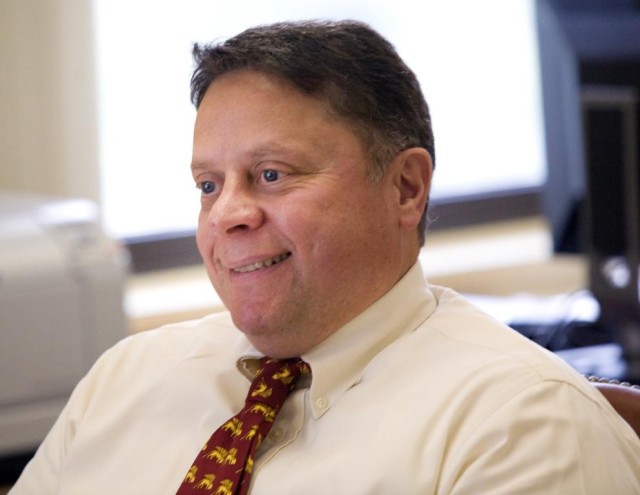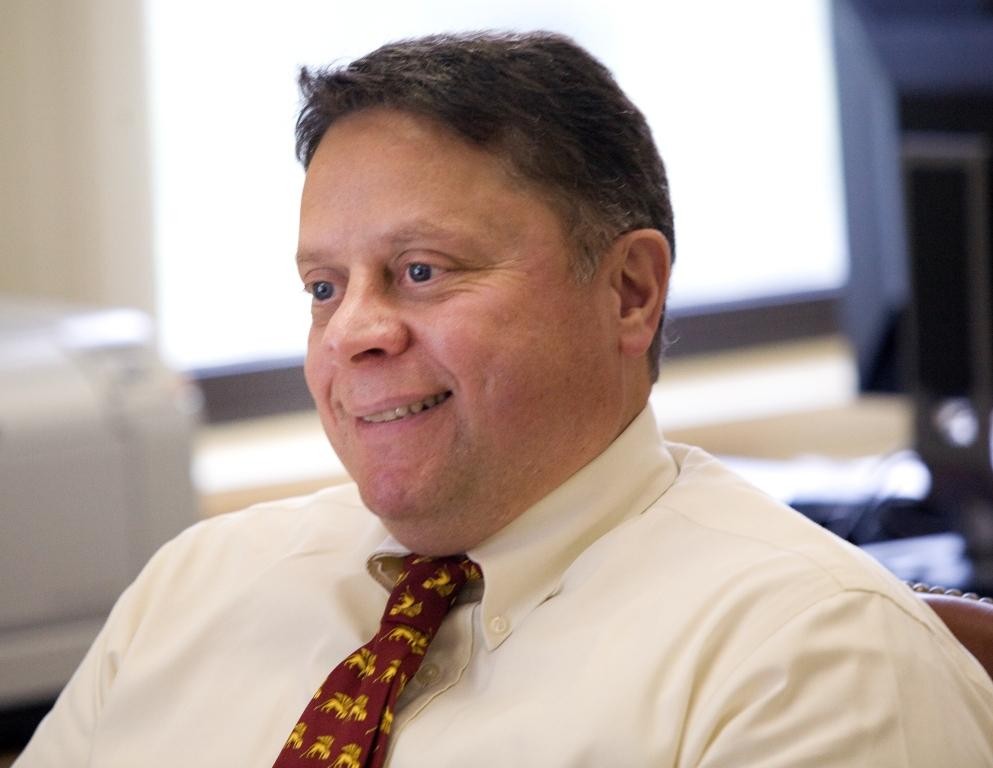"You better get down here," said the caller.
Dr. Gerardo Melendez returned the phone to the cradle. Some special operations Soldiers were downstairs in his building at Fort Monmouth, N.J.,where he served before his new assignment here as director of the U.S. Army Armament Research, Development and Engineering Center.
The "Green Berets" wanted to see the people involved with fitting specialized equipment on their vehicles operating in Iraq.
Melendez hadn't heard much specific information about how the equipment was performing.
"I guess because of the nature of their operations," said Melendez.
Based on how Melendez had shaped his early career, he might never have been in a position years later to find out what the Green Berets wanted to say.
Melendez had been a "government R&D" since 1983. After attaining a master's degree in electrical engineering from Brown University, he wanted to enter the workforce rather than go directly into a doctoral program.
He sought a job that offered the best route to higher academics, which Melendez found with the U.S. Army Communications Electronics Research, Development and Engineering Center (CERDEC) doing research and development in digital signal processing.
He planned on attaining his doctorate after a few years, then going into private industry to re-join his classmates from Brown at places like IBM or Bell Labs.
In 1993, Melendez received his Ph.D. from Drexel University, yet he never found his way back to his classmates.
Somewhere on his journey, he found that what motivates him is not the "quarterly earnings statement" so much as what those men in uniform wanted to tell his team.
"You go to work in developing some systems-and then you have some guys- and in their view their lives had been saved by the system you helped develop," said Melendez.
"That really gets you," he added.
"The capabilities we've fielded, that we've enabled the fielding of-those are always great accomplishments, especially when you get feedback. That whatever you did saved the life of a Soldier or made the life of a Soldier more bearable.
"I've been fortunate enough that I've had a few examples of that, and to a large extent that's my motivation."
Melendez found that the Army provides an experience-rich environment.
Through his continued contacts with his Brown classmates, he found that while they were doing good research they were often pigeonholed into tight disciplines four or five managerial layers below the chief technology officer (CTO).
In contrast to his former classmates, Melendez had access to high-level managers.
"Very early in my career I was going, say, to Pakistan looking at systems for the Army," Melendez recalls.
"I was running a computer facility for signal processing that was set up, basically, to do my research. I had contacts with other companies who do R&D, and I was in a position where I could call up the CTO of a company, make an appointment, and go in and see him."
As a young engineer, Melendez remembers himself as "more autocratic."
"I was of the model that if I wanted it done right, I'll do it myself," he said. "Obviously that only works up to a certain level. If you try to do it like that you end up over-worked, and you don't use all the resources available to you."
Melendez said he gradually acquired the skill that helped him work smarter with people through experiences like being appointed a team leader before he was given management responsibilities.
His evolution as an R&D manager was accompanied by increasingly greater challenges, culminating in his current position at Picatinny, where he manages more than 3,600 people and assures that systems evaluation and armaments concepts are effectively provided at all phases of the research, development, engineering and production processes.
MENTORS MATTER
Advancing from a young engineer to his current position couldn't have happened without mentors.
"I'm of the opinion that you don't just have to have one mentor. You can have multiple mentors, and you can take the best characteristics from each."
His first supervisor, Robert "Bob" Doto, is now retired but remains Melendez' mentor, as did Doto's supervisor at the time, Willie Johnson.
The two had sharply contrasting personalities, which Melendez describes as each exemplifying different sides of the Army slogan: "mission first; people always."
Melendez remembers Doto as very mission-focused, using terms like, "hyper," "whatever needed to be done," "working Saturdays or Sundays."
Johnson was "steady-state" and "calm," bringing "the human dimension."
"I think in retrospect, having been able to capture and distill those two aspects, today I feel very comfortable reaching a balance between mission and people," said Melendez.
"If I was only focused on the mission, I assure you, I could get the mission accomplished-certainly once, maybe twice. But if in the process I attrite my key resource-my people-then I have pretty much negated the possibility of accomplishing further missions.
"Having a longer-term view in which you balance mission and the people, I think, is the right approach. It gives you more of an enduring capability than one or the other."
Melendez spent several years in one assignment where he ultimately left disappointed because a materiel solution had not yet come to pass as he had hoped.
UPSIDE TO A DOWNER
He had been placed on a joint "tiger team" as the Army representative in combat identification, an endeavor devoted to helping Soldiers avoid friendly-fire casualties by making them aware when a would-be target is actually "friendly."
During his tenure, his team demonstrated technological solutions to the problem.
However, since those solutions must operate on so many of the weapons, ground vehicles and aircraft that occupy a battlefield, and since that equipment is outfitted by the Army, Navy and Marines, arriving at the solution was complex.
Adding more complexity was the fact that because the U.S. typically operates with allied nations and coalition partners, they would also have to join in the solution to avoid accidental killing among allied Soldiers.
In short, the complete and enduring solution was out of reach.
Yet Melendez learned from that disappointment.
"You really have to get many different stakeholders to align and decide whatever you're trying to do," he said.
"Convincing any one decision-maker - no matter how high up the chain - cannot solve the problem. To really be effective in getting something out there in a timely manner, you better work the whole constituency around that problem."
IN COMMAND AND CONTROL
The most rewarding period in his career, Melendez said, was in his last assignment, where he succeeded in "turning around" the CERDEC Command and Control Directorate.
But that success hinged on his ability to trust his subordinate senior leaders.
"I stepped into the job and what I found was an organization that had issues, but also had leaders willing and able to jump in and take direction and help me to move the organization in the direction I wanted," he said.
Through several strategic initiatives, the organization became focused on transitioning capabilities and on getting ready for the move to Aberdeen, Md.
"We were able to change the organizational culture from one of demonstrating systems to one of transitioning capabilities," he said.
"If a group transitioned a capability or matured a technology to bring it closer to a transition point, then we would celebrate. Transition of capabilities became our measure of success.
"At the same time, we took a very aggressive approach to get the organization ready for the move to Aberdeen. By the time I left, we were well ahead of others, with 30 percent of the workforce and their projects already moved to Aberdeen.
"Five years later, we had an organization that was considered among the best among its peers," said Melendez.
Looking back on his professional development, Melendez said he has grown the most in how he motivates the people to mesh with the mission.
"I approach the problem more in terms of aligning motivations, because dealing with that side of a person is a better way to motivate, to galvanize people, to get them behind an idea and execute.
"The role of the manager should be to understand what the mission isA,A-what are the goals-what needs to be accomplished, and try to match the people he has to the subsets of the actions that are required to accomplish the goals."
Melendez said he is still working on fully understanding the mission at the ARDEC.
He used one word to describe his reaction to his new job at Picatinny Arsenal: excited.
"The sense of community here is the strongest I've seen. This idea of a Team Picatinny, Team ARDEC, our relationships with the PEOs (program executive offices) and with the two LCMCs we are part of (Joint Munitions & Lethality and Tank & Automotive Life Cycle Management Commands), those I see as very strong and very positive features or characteristics that I plan to capitalize on to work more as a materiel enterprise."
A materiel enterprise collaborates effectively, plans well, eliminates duplicate effort, and is fast in equipping warfighters.
"The Army leadership keeps talking about the materiel enterprise, and I think we have a great opportunity here to form sort of the example-proof by example-for that idea."




Social Sharing